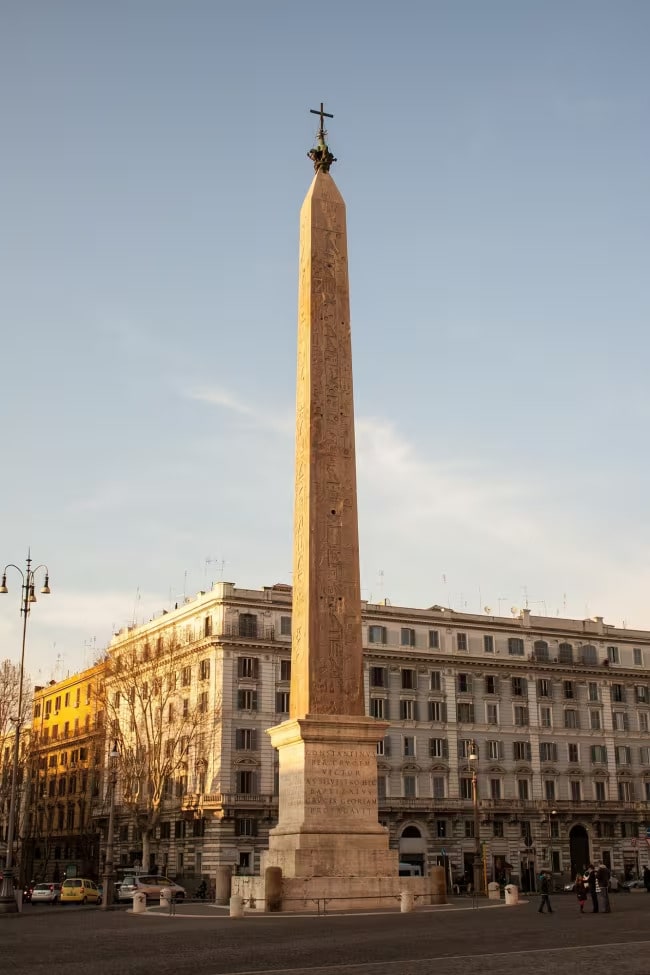In the magnificent setting of Piazza San Giovanni in Laterano, nestled within the eternal city of Rome, the Lateran Obelisk stands with an aura of imposing majesty, a timeless masterpiece that transcends both epochs and geographies.
Measuring an astounding 32.18 meters in height and boasting a colossal weight of 455 tons, this obelisk, crafted from red granite sourced from Aswan, proudly claims the title of the tallest of its kind in the world, serving as a steadfast witness to the unparalleled grandeur of ancient Egyptian civilization.
The Origins of the Obelisk
The rich history of this monumental structure traces its origins back to 1400 BC, during the reign of Pharaoh Thutmose III. Driven by a desire to honor the memory of his father, Thutmose II, the pharaoh embarked on the ambitious endeavor of erecting a red granite obelisk within the sacred precincts of the temple of Amun in Karnak, Egypt.
However, fate dictated that Thutmose III would not witness the completion of his visionary project, leaving the obelisk bereft of inscriptions. It was his grandson, Thutmose IV, who ultimately bestowed upon the obelisk its dedicatory inscriptions, honoring both his grandfather and father, and placing the monumental structure near the Temple of Amun in Thebes.
A Journey Across Continents
Yet, the journey of this colossal monument was far from over. The gaze of Augustus, the revered Roman emperor, turned toward the obelisk, envisioning its grandeur adorning the city of Rome.
Despite the imposing stature of the obelisk, superstition and apprehension regarding the wrath of the god Amun-Ra deterred Augustus from realizing his ambitions. Wisely, he chose not to provoke the deities.
However, the tides of fate would soon shift. In the 4th century AD, under the reign of Constantine the Great and his son Constantius II, both fervent proponents of Christianity, the Lateran Obelisk found itself destined for a new chapter. Unfettered by concerns of pagan superstitions, these Christian emperors orchestrated the relocation of the monolith from Alexandria, Egypt.
Initially intended for Constantinople, the burgeoning capital of the Roman Empire, the Lateran Obelisk, along with its counterpart, the Obelisk of Theodosius, found its final resting place in Rome, marking the beginning of a new era in its storied history.
From Egypt to the Circus Maximus in Rome: The Epic Journey of the Lateran Obelisk
The Lateran Obelisk embarked on a monumental journey, traversing the ancient waters of the Nile aboard a specially crafted vessel, a feat that engaged the efforts of hundreds.
Initially conceived with the ambition of gracing the city of Constantinople, the aspirations of relocating the obelisk faded with the passing of Constantine, the Great. However, his son, Constantius II, driven by a steadfast determination to uphold his father’s legacy, redirected the course of the obelisk toward Rome.
The inscriptions adorning the base of the obelisk, commissioned by Pope Sixtus V in 1588, narrate the saga of Constantine and his son: a voyage down the Nile, the construction of a colossal ship, and the triumphant passage across the Tiber to the Circus Maximus.
In 357 AD, the grand inauguration of the Lateran Obelisk within the Circus Maximus marked a pivotal moment in the annals of Rome’s history. Crowned by a gilded bronze sphere atop its apex, the obelisk stood as a towering emblem of grandeur and power.
Yet, fate, ever capricious, intervened when lightning struck the golden orb, necessitating its replacement with a bronze torch. Nevertheless, the obelisk endured as a prominent symbol of Christian Rome, embodying the triumph of Christianity over the vestiges of paganism.
The Reclamation of a Mythic Artifact
The splendor of the Lateran Obelisk, however, proved transient. As the Western Roman Empire declined, the obelisk succumbed to the ravages of time, fracturing into three segments amidst a conflagration in the 5th century. Despite its descent into obscurity, the memory of this monumental artifact persisted within the collective consciousness.
It was during the Renaissance, amidst the fervor of renewal, that Pope Sixtus V received the impetus to salvage this forgotten relic. Following an arduous quest, the obelisk was unearthed beneath seven meters of soil and sediment in 1587. Under the meticulous stewardship of architect Domenico Fontana, an extensive restoration endeavor was undertaken, resurrecting the Lateran Obelisk from the annals of history and restoring it to its former glory.
The Lateran Obelisk
On August 3, 1588, a monumental event unfolded as the towering obelisk, now adorned with a Christian cross, ascended into the sky above Lateran Square.
Bearing witness to centuries of history and cultural exchange, the inscription gracing its base narrated the saga of Pharaoh Thutmose III, the epic transfer to Rome orchestrated by Constantine and Constantius, and the meticulous restoration overseen by Pope Sixtus V.
With its newfound home in Lateran Square, embellished by a magnificent 17th-century fountain, the obelisk became an enduring fixture, an indelible part of the landscape.
Yet, the significance of the Lateran Obelisk transcends mere physicality; it embodies the convergence of civilizations, serving as a tangible link between ancient Egypt and Rome. Amidst its hieroglyphic inscriptions and commanding presence, the obelisk encapsulates the depth of history and resilience across the ages.
Source: Fran Navarro, (muy interesante)
Historian and documentation expert


#Tallest #Ancient #Egyptian #Obelisk #World


